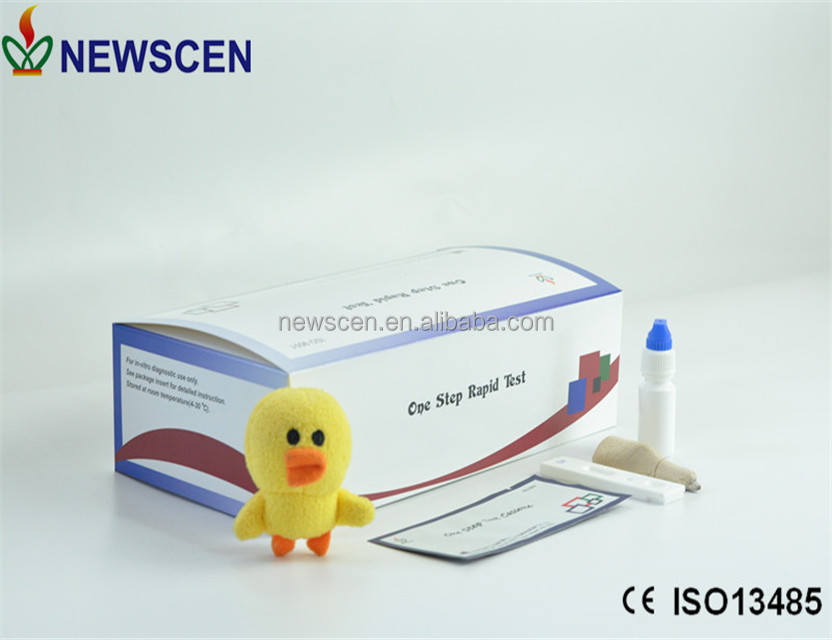INTENDED USE
One Step Influenza A Test is a rapid qualitative assay that detects influenza type A (including the subtype H1N1) nucleoprotein antigen extracted from the nasal swab specimen. The device is used to aid in the diagnosis of influenza type A infection.
For in vitro diagnostic use only. For professional use only.
SUMMARY
Influenza (commonly known as ‘flu’) is a highly contagious, acute viral infection of the respiratory tract. It is a communicable disease that is easily transmitted through the coughing and sneezing of aerosolized droplets containing live virus. Influenza outbreaks occur each year during the autumn and winter months. There are three types of influenza viruses: A, B, and C. Only influenza A viruses are further classified by subtype on the basis of the two main surface glycoproteins hemagglutinin (HA) and neuraminidase (NA). Influenza A subtypes and B viruses are further classified by strains.
Humans can be infected with influenza types A, B, and C viruses. Subtypes of influenza A that are currently circulating among people worldwide include H1N1, H1N2, and H3N2 viruses. Influenza B viruses can cause morbidity and mortality among humans, but in general are associated with less severe epidemics than influenza A viruses. Although influenza type B viruses can cause human epidemics, they have not caused pandemics. Influenza type C viruses cause mild illness in humans and do not cause epidemics or pandemics.
PRINCIPLE
One Step Influenza A Test is a rapid immunochromatographic test for the visual detection of influenza type A antigen (nucleoprotein) extracted from the nasal swab specimen. The test adopts double antibody sandwich method.
When the extracted specimen is added into the test device, the specimen is absorbed into the device by capillary action, mixes with antibody-dye conjugate, and flows across the membrane pre-coated with influenza type A monoclonal antibody.
When the influenza type A antigen levels are at or above the target cutoff (the detection limit of the test), type A antigen in the specimen binds to the specific antibody-dye conjugate and are captured by influenza type A monoclonal antibody immobilized in the relative site of test region “T” of the device. This produces a colored test band in the test region. When the influenza type A antigen levels are zero or below the target cut off, there is not a visible colored band in the test region of the device. This indicates a negative result for influenza type A.
To serve as a procedure control, a colored line will appear at the control region (C), if the test has been performed properly.
PRECAUTIONS
- This kit is for in vitro use only. Do not swallow.
- Do not mix components from different kit lots.
- Do not use test kit beyond the expiration date.
- Do not use the kit if the pouch is punctured or not well sealed.
- Keep out of the reach of children.
- Discard after use. The test device cannot be used more than once.
- The extraction tube and nasal swab are single use items – do not use with multiple specimens.
- All specimens should be treated as potentially infectious diseases. Protection glove should be worn when handling the specimen. Wash hands thoroughly afterwards.
- Avoid splashing or aerosol formation.
- DISPOSAL OF THE DIAGNOSTIC: The used device, swab and extraction tube have the infectious risk. The process of disposing the diagnostic must follow the local infectious disposal law or laboratory rule.
MATERIAL
Material provided
1.20 Individual sealed pouches, each containing
Test device
Desiccant pouch
2. 20 Extraction tubes.
3.20 Nasal swabs.
4. Two dropper bottles of extraction buffer (each 5mL): 0.1M phosphate buffer saline (PBS).
5. Leaflet with instructions for use.
Material Required But Not Provided
Timer
STORAGE AND STABILITY
- Store at 4ºC ~ 30 ºC in the sealed pouch up to the expiration date.
- Keep away from sunlight, moisture and heat.
- DO NOT FREEZE.
SPECIMEN COLLECTION AND PREPARATION
1.Take out the nasal swab provided. Tilt the head of the patient backwards to the angle of 70° and gently insert the nasal swab into the nostril which shows the most secretion.
2.Very gently rotate and push the swab until resistance is met at level of the turbinate. Gently rotate the swab against the nasal wall for a few times.
3.Patient samples perform best if tested immediately after collection.
If immediate testing is not possible, the swab should be placed in a dry, sterile plastic tube (not provided) and stored at 2ºC-4ºC for up to 8 hours.
TEST PROCEDURE
Allow the test device, specimen, and extraction buffer to equilibrate to room temperature (10°C ~30°C) prior to testing.
- Use an extraction tube (provided) for each specimen to be tested, and label each tube appropriately.
- Hold the extraction buffer bottle upside down vertically, then add 8 drops (about 400μl) of extraction buffer to the extraction tube.
- Place the specimen swab in the tube and swirl the swab for 10 times while pressing the swab head against the inside of the tube to release the specimen in the swab.
- Remove the swab while squeezing the swab head against the inside of the collection tube as you remove it to expunge as much liquid as possible from the swab. Discard the swab. Cap the tube and mix contents by gently swirling. The extraction specimen must be tested immediately.
- Remove the test device from its sealed foil pouch by tearing at the notch. Dispense 3~4 drops (80μl~100μl) of extraction specimen from the extraction tube into the sample well of the test device by inverting and squeezing the tube as shown.
- Read the test results at 15~20 minutes. DO not read test results after 30 minutes.
bio-equip.cn




